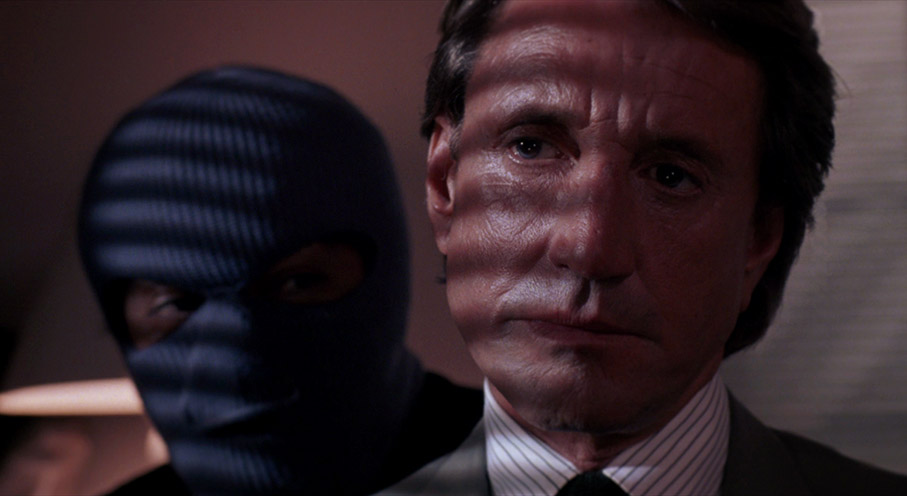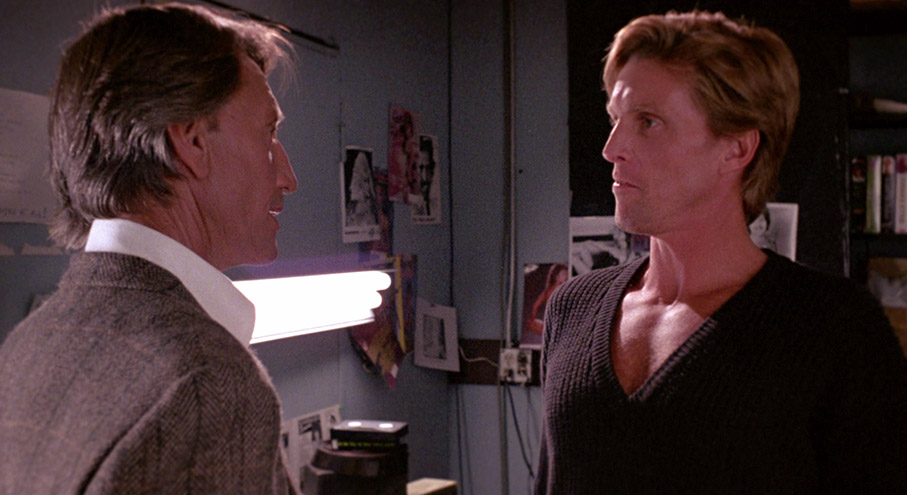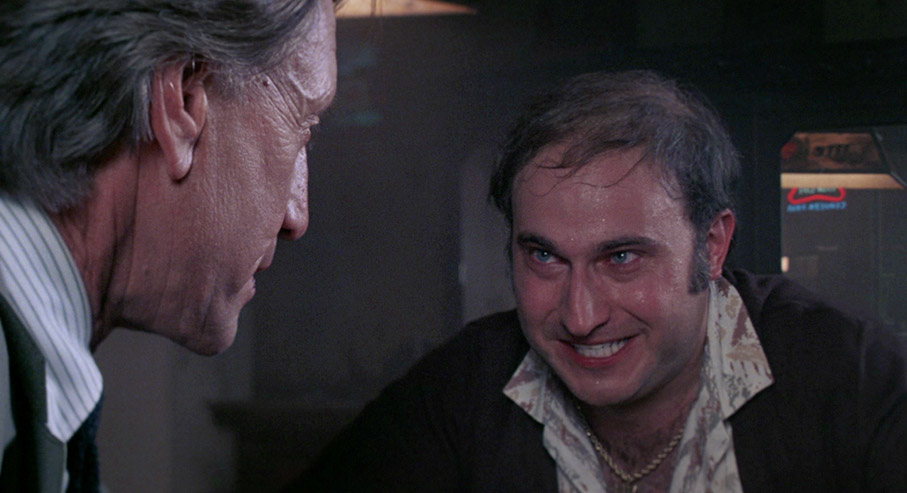|
For those who've never encountered the term, 52 Pick-Up is (or perhaps was) a gag played by kids on each other using a standard pack of playing cards. It works like this. The kid in the know waves a pack of cards at an uninformed other and asks, "Do you want to play 52 Pick-Up?" If the answer is affirmative, the kid with the cards makes a big show of shuffling and preparing them, then throws the whole pack in the air and tells the other one, "OK, now pick them up." Ha bloody ha. At least that's how it played when I was a lad. 52 Pick-Up is also the name of a 1986 American neo-noir thriller from director John Frankenheimer, one based on a novel by respected crime fiction writer Elmore Leonard. I've not read the novel, but couldn't spot a connection to the game based on how things play out on screen. I'm guessing there isn't one.
So what's the story? Industrialist Harry Mitchell lives in Los Angeles with his wife Barbara, who is running for city council. But Harry's been having an affair with the younger Cini, and one night he's visited by three masked men, who threaten to show evidence of the affair to his wife if he doesn't cough up an oddly specific $105,000. As going to the police would make the affair public and impact on Barbara's political ambitions, Harry instead decides to come clean about the affair and tell his would-be blackmailers to stuff it. They respond by killing Cini and framing Harry for the murder, evidence of which they promise to send to the police unless he pays them $105,000 every year for the rest of his life. But Harry's finances are not all they probably should be for a man in his position, so he approaches the blackmailers with a counter offer consisting of all the money he has, $52,000. Ah, now the title starts to make sense.

52 Pick-Up is certainly built on solid foundations. As I said, I've not read Elmore Leonard's novel but I gather that this is a largely faithful adaptation (Leonard's co-screenplay credit was apparently given to him by Frankenheimer purely because they used so much of the novel in the film) that plays with conventions in interesting ways. For a start, the blackmailers aren't seasoned professionals but newcomers to this particular form of extortion. Consisting of sociopathic porno cameraman Alan Raimy, hard man Bobby Shy and perennially nervous porn joint manager Leo Franks, they're not exactly brilliant at covering their tracks, which allows the resourceful Harry to track each of them down and directly confront front man Raimy about the gang's demands. This leads to a highlight scene in which Harry invites Raimy to visit his factory and inspect the books, in the process convincing him that he really only has the aforementioned $52,000 to his name. What intrigues about this sequence is the business-like manner in which this process is conducted and Raimy's willingness to accept the authenticity of the presented evidence and adjust his deal accordingly. It also serves to confirm Raimy's sociopathy – despite having gleefully murdered Cini, he seems to enjoy his whole encounter with Harry – and marks the kicking-off point for the psychological games Harry plays with the individual gang members in an effort to turn them against each other.
52 Pick-Up is not big on action and moves along at a methodical pace, neither of which I have a problem with. But it also doesn't grip in the way I couldn't help thinking that it probably should, and I've had trouble putting my finger on exactly why. It's workmanlike rather than slick, in a way that almost seems designed to reflect the gang's sometimes stumbling semi-professionalism, but sharpening up when either side makes a move that disadvantages the other. It's also one of the most visually dour American mainstream films of its day, a calculated rejection of the brash colour and high-key lighting that we tend to associate with 80s American cinema, a more muted look for a largely low-key noir.

There are no dud scenes but no real standout ones either, despite a sprinkling of memorable moments. Even the videotaped execution of Cini – all jokey theatrics on Raimy's part while his victim screams for mercy – had its impact dented the very same year by the altogether more disturbing videotaped murders in John McNaughton's Henry: Portrait of a Serial Killer, while the passing of time and subsequent darkening of thriller cinema has helped to soften its likely once-strong impact further. Raimy's staging of this killing for camera also (inadvertently) serves to misdirect. I'm guessing the decision to have him tie a wooden board to Cini's naked chest to shoot the bullets through was a low-budget way around the special effects challenge of showing bullets puncturing human flesh, but Raimy's presentation of the board and the bullet holes to camera afterwards, which plays like a stage magician challenging the audience to work out how his trick was done, wrongly convinced me that the murder was actually a carefully stage-managed con.
As Harry, Roy Scheider is as dependable as ever, reigning his emotions in until they can do little but explode and having just the right tone of "don't you realise that I'm fucking with you, sonny?" in his later dealings with Shy and Franks. Initially, at least, I wasn't quite so sure about Julian Glover's more animated performance as Raimy – his sometimes theatrical instability never really comes across as threatening, but when he's enjoying the game, as in his aforementioned face-to-face with Harry, he's great fun to watch and there really is a sense that the cogs are turning behind the façade (that said, a little part of me couldn't help wondering what someone like Willem Dafoe might have done with this role). Clarence Williams brings a brutish air of menace to Bobby Shy, despite a couple of slightly artificial line deliveries, and while she doesn't get that much to do as Barbara except look worried and annoyed in the early stages, when she's kidnapped later, Ann-Margret fights her captor like her life really does depend on her breaking free.

I gather some elements were trimmed in the translation from novel to film screenplay (they always are), but this does result in the need for some creative supposition on the audience's part. A prime example is Leo Franks, who though tied to Raimy through his daytime job, is such a terrified ball of panic when things start to turn sour that it's hard to imagine him assisting with the murder of Cini without fainting on the spot or being transformed into a nervous wreck from that point on. Yet when Harry pays him his first investigative visit, Franks is his usual brusque and cheerful self and acts as if he's never has a seriously traumatic moment in his life. The finale also raises its share of questions, a twist we know is coming in some form or other but whose nature left me wondering how and where its perpetrator gained the necessary skills and materials to pull this off in such a short space of time. And maybe I was suffering from Roy Scheider déjà-vu here, but Raimy's habit of repeatedly calling Harry '‘sport' left me in no doubt that if the tables were turned, Harry would turn that expression back on him, much as Scheider did as Officer Frank Murphy with his smug nemesis Colonel Cochrane's "Catch you later" in Blue Thunder three years earlier.
But 52 Pick-Up is still a solidly made and involving crime thriller with its share of small but still notable rewards. It's certainly aged better than many of its contemporaries, in part because it chooses not to embrace the brash aesthetic and fondness for loudly executed showpiece scenes that have dated so many of them. I can't readily recall another film in which sunny Los Angeles feels so alternatively dour and sleazy, even when the sun is shining, and it has the dubious distinction of featuring more actual porn stars in the cast than any mainstream movie until it was usurped by Paul Thomas Anderson's Boogie Nights, which was set in the adult entertainment industry. Ronin it's not, but this is still one of Frankenheimer's stronger late career works, and despite my reservations is one I plan to intermittently revisit.
As I hinted above, 52 Pick-Up is not the most visually lively of films, with sets and clothing designed to strip scenes of bright colours and interiors lit in often undramatic and even naturalistic fashion with faces often sitting in shadow. The image can thus sometimes look a little glum, but there are notable exceptions – Raimy's pad in particular is littered with coloured lights, which are vividly rendered here, and some daylight exteriors really do pop. The contrast balance is kind to darker scenes, though the shadows do intermittently deepen to coal-hole black when they need to. Though it isn't always obvious in the gloomier sequences, when the light is right the detail is pleasingly crisp. Dust and damage have been largely banished. Nice.

The Linear PCM 2.0 stereo track is very clear and boasts a decent dynamic range, something particularly evident when music kicks in.
Optional English subtitles for the deaf and hearing impaired are available.
Commentary by Glenn Kenny and Doug Brod
Film writers Glenn Kenny and Doug Brod – both formerly of Video Review magazine – provide a lively fact and trivia based commentary on the film. We get info and observations on Cannon Films, novelist Elmore Leonard, director John Frankenheimer, several of the actors, the differences between the novel and the film, and a good deal more. They observe that Ann-Margaret spends much of the film clutching onto things (tables, door frames, cupboards) and that John Glover looks like James Spader's sick uncle, and tell long stories about meeting porn actor Ron Jeremy (who only appears in the film for a couple of seconds), quote from some of the contemporary reviews (including Kenny's own – he's grown to like the film a lot more than he once did), and note the influence of George V. Higgins' novel The Friends of Eddie Coyle on Leonard's writing. In an up-to-date bit of social commentary, Kenny recalls Julian Glover's role as a Donald Trump-like figure in Gremlins 2 and remarks, "Unfortunately the United States itself may not be saved by Gremlins in a similar fashion." Oh, if only.
Hardcore Cameos (12:10)
Here Glenn Kenny and Doug Brod trip through three scenes that feature real-world porn stars, fast-forwarding and pausing to identify them all and tell us a little about them. All rather interesting, though having told us stories about Ron Jeremy on the main commentary that suggests they got on well when they individually met him, here Kenny seems to counter that when he says suggestively, "We've both had conversations with Ron Jeremy and they have not gone well." I could do with a little expansion on that.
Theatrical Trailer (1:44)
An attempt to sell the film as a high-octane action thriller. Well, it is a Cannon production.
If you get your hands on a first pressing of the disc, you'll also get a collector's booklet containing new writing on the film by the Badlands Collective, but we've not seen that.
I'm still not sure exactly how I feel about 52 Pick-Up, a film I enjoyed without getting fired up by. It's still one of the better films to wear the Cannon label and one that did John Frankenheimer's serious rep no harm, something you can't say about all of his late career works. It's well served by the HD transfer on the Blu-ray in this dual format set, and while the extra features are a bit thin on the ground for Arrow release, the commentary is a good one. Cautiously recommended.
|